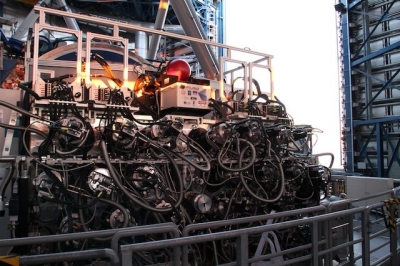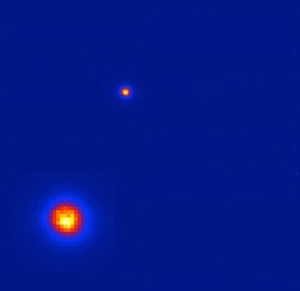MUSE Overview
Work based on MUSE observations should cite the paper Bacon et al., SPIE 7735, 7 (2010).
Introduction
MUSE, the Multi-Unit Spectroscopic Explorer, is an Integral Field Spectrograph located at the Nasmyth B focus of Yepun, the VLT UT4 telescope. It has a modular structure composed of 24 identical integral-field units (IFU) that together sample, in Wide Field Mode (WFM), a near-contiguous 1 squared arcmin field of view. Spectrally the instrument samples almost the full optical domain with a mean resolution of 3000. Spatially, the instrument samples the sky with 0.2 arcseconds spatial pixels in the Wide Field Mode with natural seeing (WFM-noAO).
Since P101 MUSE offers the ground-layer adaptive optics (GLAO) mode of the VLT Adaptive Optics Facility (AOF) via the GALACSI adaptive optics module, offering an AO corrected 1'x1' field of view with 0.2 arcseconds sampling (WFM-AO). Starting P103 offers a 7.5x7.5 arcsec2 laser-tomography adaptive optics (LTAO) corrected field of view sampled at 0.025"/pixel (NFM-AO).
Science Objectives
- Formation of galaxies
- Nearby galaxies
- Stars and resolved stellar populations
- Solar system
- Serendipity

MUSE in a nutshell
The table below gives the basic parameters of the instrument.
| Number of IFU modules | 24 |
| Wavelength range | 480-930 nm (nominal) 465-930 nm (extended) |
| Detectors | 24 x 4k x 4k MIT/LL CCD |
| AO type | noAO, Ground layer AO, and LTAO, 4x22 W lasers |
| Throughput WFM |
14 % (480 nm) 35 % (750 nm) 14 % (930 nm) |
| Throughput NFM | 13 % (480 nm) 26 % (750 nm) 11 % (930 nm) |
Wide Field Mode (Currently offered)
| Field of view | 59.9"x 60.0" |
| Spatial Sampling | 0.2" /pixel |
| Spatial resolution (FWHM) | 0.4" @ 700nm |
| Resolving power | 1770 (480 nm) -- 3590 (930 nm) |
Limiting magnitude (1 hr, airmass=1.0, seeing 0.8"@V) |
VAB = 22.64 mag (550 nm) IAB= 22.28 mag (784.9 nm) |
Wide Field Mode with AO (Currently offered)
| Gain in ensquared energy within one pixel with respect to seeing | 2 |
| Condition of operation with AO | 70th percentile |
| Sky coverage with AO | 70% at Galactic Pole |
Narrow Field Mode (Currently offered)
| Field of view | 7.42" x 7.43" |
| Spatial Sampling | 0.025" / pixel |
| Spatial resolution(FWHM) | 55 mas - 80 mas |
| Resolving power | 1740 (480 nm) -- 3450 (930 nm) |
| Ensquared Energy (25 mas) | 10% - 1% |
| Predicted limiting flux in 1 hr | 2.3x10-18 erg s-1 cm-2 |
| Predicted limiting magnitude in 1 hr | RAB = 22.3 mag |
| Predicted limiting surface brightness in 1 hr | RAB = 17.3 mag arcsec-2 |
Calibration Plan
These are the main performed as part of the standard calibration plan.
| Calibration | No. of exposures (per mode) | Frequency | Phase | Purpose |
|---|---|---|---|---|
| Bias | 11 | Daily | Day | Master bias, bias characteristics |
Dark |
5*1800s |
Monthly | Day | Master dark, dark current |
| Geometrical calibration: Multi-Pinhole mask with arc lamps |
80 | Bi-Monthly | Day | Relative location of the slices |
| Flat-field with continuum lamp | 11 | Daily (a) | Day | Illumination correction, Tracing solution, Background light, Instrument throughput. |
Arc lamp exposures |
5 per lamp (b) | Daily (a) | Day | Wavelength solution, Dispersion characteristics |
| Flat-field with sky | >3 | Weekly | Twilight | Large scale illumination correction |
| Flat-field with continuum lamp | n (c) | hourly during the night |
Nights | Illumination correction |
| Attached Flat-field with continuum lamp | n | On request | Night | High-precision flat-fielding |
Attached arc lamp exposures |
n | On request | Night | High-precision wavelength solution |
| Spectrophotometric calibration | 1 |
(d) | Night | Absolute flux calibration. Optional: Telluric correction |
| Telluric star | n | On request | Night | Telluric correction |
| Astrometry | 1 | Bi-Monthly | Night | Astrometric model |
(a) Every day we obtain flats and arcs as described below for mode WFM-NOAO-E. All other modes are calibrated if used during the night.
(b) The default is to obtain five exposure per lamp for each of the Ne, Xe, and HgCd lamps. Every 90 days we take 15 frames per lamp to obtain the Line Spread Function (LSF).
(c) These single flat fields are taken automatically in WFM-NOAO-N at hourly intervals during the night or when the change in temperature is above 0.3 degrees.
(d) During clear or photometric nights in which MUSE science OBs are executed.
Instrument overheads
The table below gives the instrumental overheads that can be used for the proposal preparation phase.
| Acquisition |
Telescope preset | 360 |
| Interactive acquisition loop |
120 |
|
| AO loops closure (for WFM and NFM AO modes only) | 180 | |
| Slow guiding loop closure |
90 |
|
Observation |
Detector setup | 15 |
| Detector readout + file merging |
80 |
|
| Telescope offset < 2' | 15 | |
| SGS loop closure for large ofsets | 90 | |
| Derotator offset |
0.11s/degree | |
| Attached calibration |
Attached flat (5 flats) |
250s+112s/flat-field |
| Attached arcs (3 calibrations, 1 per lamp) |
180s + 112s/exposure (1 per lamp) |
Examples of overhead computation
Example 1. Not using SGS
Ttotal = 360s (preset) + Tacq + 120s (acquisition, 1 iteration) + N*(15s+UIT+80s)
with Tacq the acquisition integration time, and UIT the integration time of each of the N exposures.
Example 2. using the SGS with small telescope offsets and no PA offsets
Ttotal = 360s (preset) + Tacq + 120s (acquisition, 1 iteration) + 90s (SGS loop closure) +N*(15s+UIT+80s+15s (telescope offset) )
Example 3. using the SGS with large telescope offsets and PA offsets
In that case we are assuming that the SGS has to close the loop after each offset/rotation because it has lost the current guide stars.
Ttotal = 360s (preset) + Tacq + 120s (acquisition, 1 iteration) + 90s (SGS loop closure) +N*(15s+UIT+80s+15s (telescope offset) + 20s (PA rotation) + 90s (SGS loop closure))
MUSE Science show case 1: Kapteyn's Star
First light image of a M1 red dwarf of 9th magnitude, in the constellation of Pictor, named after the dutch astronomer Jacobus Kapteyn who discover it in 1898.

